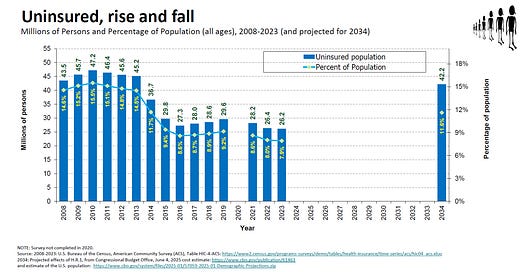The "Big Bill" (H.R.1) would raise the uninsured by nearly 60% in the next ten years, wiping out most of the gains since the ACA
The uninsured in the U.S. dropped by about 40% since the passage of the ACA; projected effects of legislation would raise uninsured 60%, nearly wiping out all the gains since the ACA was implemented
June 5 — Congress is currently debating the passage of H.R.1 (the “big” bill), the reconciliation bill. Estimates produced June 4 by the Congressional Budget Office suggest that this legislation would add 10.9 million to the number of uninsured persons by 2034, and an increase of 16 million uninsured when combined with the effects of baseline changes already written into law, especially the expiration of expiration of the expanded premium tax credit.
Putting these changes into context, a rise of 16 million in the uninsured between now and 2034 would raise the uninsured to an estimated 42.2 million in 2034, since in 2023 the uninsured was 26.2 million, according to the U.S. Census Bureau (see graph). The total uninsured (all persons) was 45.2 million in 2013 before implementation of the provisions of the Affordable Care Act, according the Census. Thus the uninsured has dropped 42% since 2013, largely because of the creation of the marketplaces and the expansion of Medicaid. A rise of 16 million in the uninsured between now and 2034 would erase almost all (84%) of the reduction in the uninsured since 2013, and raise the uninsured number by 60%. In percentage terms, the uninsured rate was 14.5% in 2013, but dropped to 7.9% in 2023 and would be projected to rise to 11.6% in 2034 using the CBO projections (and this author’s calculations, including estimates of the U.S. population in 2034).
Uninsured in Missouri. Estimates produced by the Kaiser Foundation have used the CBO estimates (described above) and allocated these estimates to the state level. These estimates suggest that the legislation would add 190,000 to the uninsured in Missouri (including the effects of expiration of the premiums credits for the marketplace plans) by 2034.
Putting these changes into context, a rise of 190 thousand in the uninsured in Missouri between now and 2034 would raise the uninsured to an estimated 648 thousand in 2034, since in 2023 the uninsured was 458 thousand, according to the U.S. Census Bureau (see graph).
Putting this into context, the total uninsured (all persons) was 773 thousand in Missouri in 2013 before implementation of the provisions of the Affordable Care Act, according the Census. Thus the uninsured has dropped 41% since 2013, largely because of the creation of the marketplaces and the expansion of Medicaid after 2021. A rise of 190,000 in the uninsured between now and 2034 would erase about 60% of the reduction in the uninsured in Missouri since 2013, and raise the uninsured number by 40%. In percentage terms, the uninsured rate for Missouri was 13% in 2013, but dropped to 7.5% in 2023 and would be projected to rise to 9.9% in 2034 using the CBO projections (and this author’s calculations, including estimates of the Missouri population in 2034).





